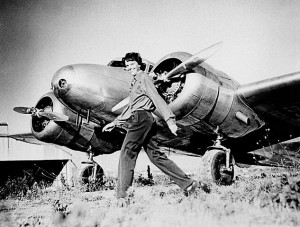 One of the most enduring mysteries of the twentieth century that remains to be is the disappearance of Amelia Earhart. To this day many still wonder if she was a spy.
One of the most enduring mysteries of the twentieth century that remains to be is the disappearance of Amelia Earhart. To this day many still wonder if she was a spy.
When Earhart’s plane disappeared on July 3, 1937, President Roosevelt ordered a massive naval search. It lasted one week, cost millions of dollars, and covered approximately 250,000 miles. But Earhart, the navigator Fred Noonan, and her Lockheed Electra aircraft had simply disappeared.
Officials concluded that Earhart had run out of gas and downed somewhere in the ocean. In the years since then, however, the official story has repeatedly been challenged. One of the most persistent and intriguing of the alternative possibilities recast Earhart and Noonan as spies for the United States. According to this scenario, their round-the-world adventure was merely a cover, with their actual mission being to take pictures of Japanese installations in the Pacific. In some versions of this story, they were shot down over the Pacific; and in other versions, they were captured and executed.
The origins of the spy theory originated in 1943 in the movie Flight for Freedom starring Rosalind Russell as the famous aviator and Fred McMurray as the navigator she falls in love with. The movie was pure fiction, but it captured the imagination of the public and of generations of journalists, historians, and aviation buffs. Since then, many have worked to prove it more than fiction.
One of the leading proponents of the spy story was CBS reporter Fred Goerner. In 1960, he came across a newspaper article about a woman who said that while she was a girl on Saipan Island, she witnessed the plane crash in the harbor. She also said she has seen a white woman and man taken into Japanese custody after the crash.
Know what the weather forecast is for your area at all times!
Goerner spent six years investigating the matter, interviewing hundreds of the islanders, who claimed to have seen Earhart and Noonan. He concluded that the two landed somewhere in the Marshall Islands, were picked up by a Japanese fishing boat, and taken to the Japanese Pacific military headquarters on Saipan. But some of the reporter’s evidence doesn’t stand up closer investigation: the remains in an unmarked grave turned out to be of a non-Caucasian woman and parts of the twin engine airplane he recovered turned out to be made in Japan.
Even more problematic were the contradictory stories of the islanders. Some claimed they saw only a woman. Others said they saw a man and a woman. Some saw the plane wrecked, while others saw it undamaged. Some claim the flyers were executed, but others said they were imprisoned for many years before they died. Even so, there were many unanswered questions about the mysterious disappearance.
Randall Brink spent thirteen years analyzing documents obtained through the Freedom of Information Act and his conclusion was the same as Goerner: Amelia Earhart was a spy. According to Brink, Earhart’s trip began as a publicity stunt but later evolved into a spy mission. As a personal friend of the Roosevelts, she did not hesitate to approach the President for help in arranging for refueling stops during her trip. And the president could not overcome the temptation to use the trip for military intelligence.
Brink’s detractors argue that his evidence is circumstantial and that he grossly overstated his case. And some of the speculation was indeed off the wall. Brink even went so far as to say the captured Earhart had become Tokyo Rose, the infamous wartime disc jockey who tried to get GIs to defect. At one point, Earhart’s husband made a special trip to the front lines to listen to a Tokyo Rose broadcast and said he would stake his life that it was not his wife’s voice.
Everyone loves a good conspiracy, but this is probably not one of the ones that can be justified by facts. Earhart was an ardent pacifist, likely to have resisted anything to do with the military. Beyond that, there were plenty of other motivations for the trip besides spying— chief among them money. Her disappearance can be explained without resorting to spy stories. The trip from New Guinea to Howland Island was notoriously dangerous. The island was tiny, remote, and barely above sea level. Under the best of circumstances, it was difficult to find.
None of this proves that Earhart was not a spy. But it is worth noting that most of her biographers have concluded she was simply an explorer. Nevertheless, the disappearance of Amelia Earhart still has a place in the American imagination.
©2012 Off the Grid News
 Off The Grid News Better Ideas For Off The Grid Living
Off The Grid News Better Ideas For Off The Grid Living


